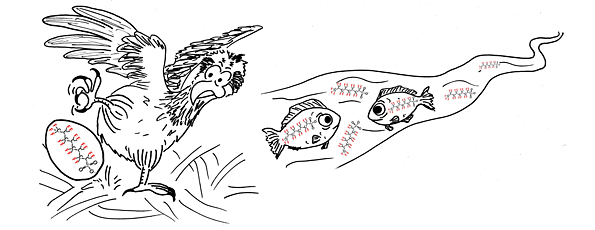The Organics team analyses biotic and abiotic samples for a large variety of organic substances found in the environment.
These include:
- Non-polar, hydrophobic, persistent and toxic compounds that bio-accumulate in the food chain, e.g. persistent organic pollutants
- Polar, less persistent, water soluble compounds that are mobile in the ecosystem and exhibit a range of toxicities e.g. steroid hormone endocrine disrupters
- Ecologically relevant chemicals e.g. phytopigments and phospholipids

Our experienced and motivated staff, and our state-of-the-art instrumentation, have allowed us to adapt our methods to specific scientific needs. It also means we are able to develop methods for the analysis of “new” and “emerging” compounds of interest.
Organics team capability
Environmental organic analysts at UKCEH are able to analyse a wide range of organic compounds including:
- Rodenticides in liver samples
- Cytotoxic compounds in water
- Phytopigments
- Algal toxins
- Carbonyls
- Progesterones
- Polycyclic aromatic hydrocarbons (PAHs), including separation of the total and freely dissolved fraction in water
- Polycyclic aromatic hydrocarbons (PAHs) in biota
- Organochlorine pesticides
- Polychlorinated naphthalenes (PCNs)
- Polychlorinated biphenyls (PCBs)
- Polybrominated diphenyl ethers (PBDEs)
- New brominated and chlorinated flame retardants
- Phospholipid fatty acids
- Size fractionation of the dissolved organic carbon
Please ask if the compounds you are interested in are not listed here.
Equipment
- GC-MS systems - equipped with autosampler for liquid low and large volume injection, headspace and SPMD injection, programmed temperature vaporisation inlet, ionisation source capable of operating in electron impact and chemical ionisation mode.
- LC-MSMS system - equipped with autosampler and triple-stage quadrupole mass spectrometer.
- HPLC systems - equipped with autosampler, fraction collector, multiple wavelength detector, diode array detector and fluorescence detector
- Accelerated solvent extraction
- Solid phase extraction workstations
Sample types
A large variety of sample media can be analysed such as:
- Water
- Sewage
- Sediment and soil
- Biota, e.g. bird eggs, bird and mammal livers, worms and mussel tissues, etc.
Our methods may be adapted to additional sample types as required.
Projects
Example projects across UKCEH involving the organic chemistry team include:
Predatory Bird Monitoring Scheme
A long-term, national monitoring scheme that analyses the contaminant levels in the livers and eggs of certain predatory and fish-eating birds in Britain.
Organic chemistry role:
- to quantify “old” and “new” persistent organic compounds in birds and eggs of different species of birds of prey and
- to quantify second generation rodenticides in livers from birds of prey.
The occurrence of natural and synthetic progesterones in sewage effluent
This project focus on the presence and effects of steroid hormones, in particular natural progesterone and its synthetic analogue, norgestrel, a key ingredient in the contraceptive pill.
Organic chemistry role:
- to develop a quantitative method for the determination of natural progesterone and the synthetic derivative norgestrel in sewage effluent, with a limit of detection of less than 1 ng/L, and
- to determine progesterone and norgestrel in a series of flow-weighted samples of sewage effluent taken from a number of sewage treatment plants located across England.
ENVICAT - ENVIronmental control of CyAnoToxins production
Algal blooms, when algae takes over freshwater systems, release harmful cyanobacterial toxins (e.g. microcystins). Despite attracting considerable investigation for a number of decades, the factors that promote toxin production are still poorly understood and difficult to predict. The ENVICAT project aims to further the understanding of this area through studying cyanotoxin production using ecophysiological, analytical chemical and molecular approaches, as well as analysis of large-scale environmental databases.
Organic chemistry role:
- to develop a quantitative method for the determination of microcystin variants and
- to quantify the microcystin variants in the algal samples resultant from the laboratory experiment.
Environmental change and rising DOC trends: Implications for public health (Environment and Health ERA-Net - health effects of climate change)
This project addresses the health implications for drinking water of a recently observed rise in Dissolved Organic Carbon (DOC), a key determinant of water quality.
The removal process during treatment of drinking water can give rise to toxic artefacts. The Work Package 4 attempts to determine whether rising DOC levels will increase the amount of toxins that make their way into drinking water treatment works from contaminated areas of the catchment.
Organic chemistry role:
The focus of the project for the Lancaster Organics group is within Work Package 4, which is shared with the Utrecht team: What are the implications of predicted changes in DOC concentration/flux and quality for the transport of chemical contaminants from catchments into and within the water treatment process?